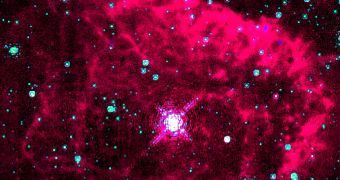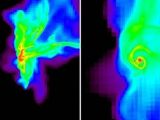If you think our Sun is a big star, you've seen nothing! Behemoths as large as 120 solar masses lie all around the universe. Theory predicts that stars cannot grow larger than 150 times the mass of the Sun, either that or something drastic must happen, as stellar evolution models cannot explain such objects. Two astrophysicists from the University of California Berkeley and Princeton University, Chrisopher McKee and Mark Krumholz, set up to creating a mathematical model that explains how stars 100 times bigger than our Sun can form out of massive gas clouds.
You just have to look up, towards the sky to realize that something is wrong. There aren't a lot of bright stars around us, in the sense that massive stars are usually extremely luminous. In fact, the brightest star on the night sky, Sirius A, is a faint white dwarf in a binary system with a smaller stellar companion, Sirius B. Massive stars are about one million times rarer in the visible universe than stars comparable in size to the Sun, which have an average individual mass of about 80 percent of a solar mass.
The problem is, Krumholz says, that the force that drives the star formation process, gravity, also prevents the formation of massive stars. Instead of pulling them all together, gravity tends to break apart the massive gas clouds into smaller pieces, to form smaller stars. Only when molecular gas is being heated by the radiation received from nearby stars, the cloud can smooth out and start to collapse into a truly massive object. Even so, with a clear disadvantage in relation to smaller stars, massive stars are still the dominant component shaping the universe into the form we see it today.
They are able to push large quantities of gas and dust across interstellar distances, and heat it up so that other stars can then form. Massive stars also contribute to most of the quantity of heavy elements in the universe, because they have a extremely short life - a couple million years - during which time they rapidly burn hydrogen gas into ever heavier elements, essential for the appearance of life in the universe.
To create a massive star, the gas cloud requires densities thousands of times higher than the average density of a cloud required for the formation of a Sun-like star. Because the gravity tends to break the gas cloud into smaller pieces, the key to massive star formation is compacting the cloud into a small volume, after which it may take control. The second issue is that excessive heaving can in fact stop the collapse of a gas cloud, also forcing it to break up and form small stars.
According to Krumholz, massive stars experience preferential locations in galaxies, meaning they can't form in any region of a galaxy. The rough number of massive stars is usually estimated by studying the overall luminosity within a galaxy. The ratio between small stars and massive stars may be just an error of approximating the formation rate of massive stars in the distant regions of the universe.

 14 DAY TRIAL //
14 DAY TRIAL // 
